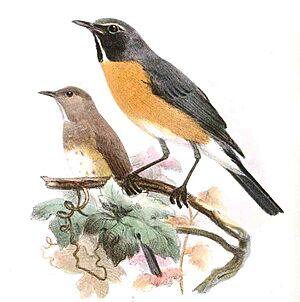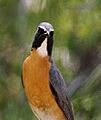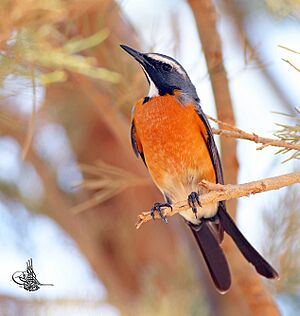White-throated robin facts for kids
Quick facts for kids White-throated robin |
|
|---|---|
 |
|
| female and male | |
| Conservation status | |
| Scientific classification | |
| Synonyms | |
|
The white-throated robin (Irania gutturalis), also called the irania, is a small, migratory passerine bird. Passerine birds are often called "perching birds" because of how their feet are made. This bird shows sexual dimorphism, which means the male and female look different.
The name Irania comes from Iran, which is where this bird was first officially found and described. The name gutturalis is an old Latin word meaning "of the throat," referring to the bird's white throat. White-throated robins breed in western Asia and fly to East Africa for the winter.
Contents
About the White-throated Robin
The white-throated robin used to be grouped with the thrush family. However, scientists now mostly agree it belongs to the Old World flycatcher family, called Muscicapidae. This bird, and others like it, are often called "chats."
What Does a White-throated Robin Look Like?
This bird is a bit bigger than the European robin. It is about 16 centimeters (6.3 inches) long. Its wingspan can reach about 28 centimeters (11 inches).
The male white-throated robin is quite colorful when it's breeding. It has lead-grey feathers on its back and wings. Its face is black, but it has a bright white throat and a white stripe above its eye, called a supercilium. Its belly is a bright orange color. The tail and strong beak are black.
Female white-throated robins are not as colorful as the males. They are mostly grey. They have a black tail and a little bit of orange on their sides. You might also see some white streaks on their throat.
What Does the White-throated Robin Sound Like?
The male white-throated robin sings a fast, chattering song. It often sings from a bush or while flying. The call of this bird sounds like a double note, "chis-it." It is similar to the call of a pied wagtail.
What Do White-throated Robins Eat?
White-throated robins mainly eat insects. They are known as insectivorous birds. However, when autumn comes, they will also eat fruit.
Where Do White-throated Robins Live?
The white-throated robin is a migratory bird. This means it travels long distances between its breeding and wintering grounds.
Breeding Areas
These birds breed in western Asia, in countries from Turkey to Afghanistan. Their favorite breeding spots are dry, rocky slopes with some bushes. They often choose places that are high up in the mountains.
Wintering Areas
For the winter, white-throated robins fly to East Africa. There, they live in dense bushes in dry areas. They especially like woodlands with Acacia and Commiphora trees on the dry central plateau.
A small number of these birds reach the Usangu Plains in Ruaha National Park in Tanzania. This is usually as far south as they go. But in very dry years, some might travel even further south. They can reach wetter, higher lands about 1,600 meters (5,200 feet) above sea level. Sometimes, a very few white-throated robins are seen in Europe, but this is very rare.
Reproduction and Life Cycle
The white-throated robin builds its nest in a shrub. The female usually lays 4 to 5 eggs.
Images for kids





